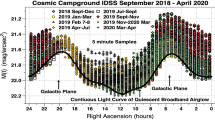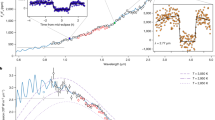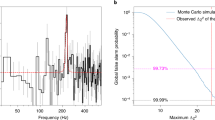Abstract
THE spectrum of the new star in Cygnus is changeable, and is now very unlike Cornu's representation of it in a recent number of NATURE (vol. xv., p. 158). Your readers may not be aware that it is easy to see several of the bright lines without a powerful instrument, though not to measure them accurately. As observed with a Browning's “miniature spectroscope” attached to a 4¼ inch refractor, the brightest line is now about at wave-length 503, and is probably that described by Cornu as sixth in order of brightness, at wave-length 500. At the end of last month the brightest line was about 484, probably the F hydrogen line. Since December 27 the new star has always appeared to me orange. Has not this star received any name yet?
This is a preview of subscription content, access via your institution
Access options
Subscribe to this journal
Receive 51 print issues and online access
$199.00 per year
only $3.90 per issue
Buy this article
- Purchase on SpringerLink
- Instant access to full article PDF
Prices may be subject to local taxes which are calculated during checkout
Similar content being viewed by others
Author information
Authors and Affiliations
Rights and permissions
About this article
Cite this article
BACKHOUSE, T. Spectrum of New Star. Nature 15, 295–296 (1877). https://doi.org/10.1038/015295e0
Issue date:
DOI: https://doi.org/10.1038/015295e0



